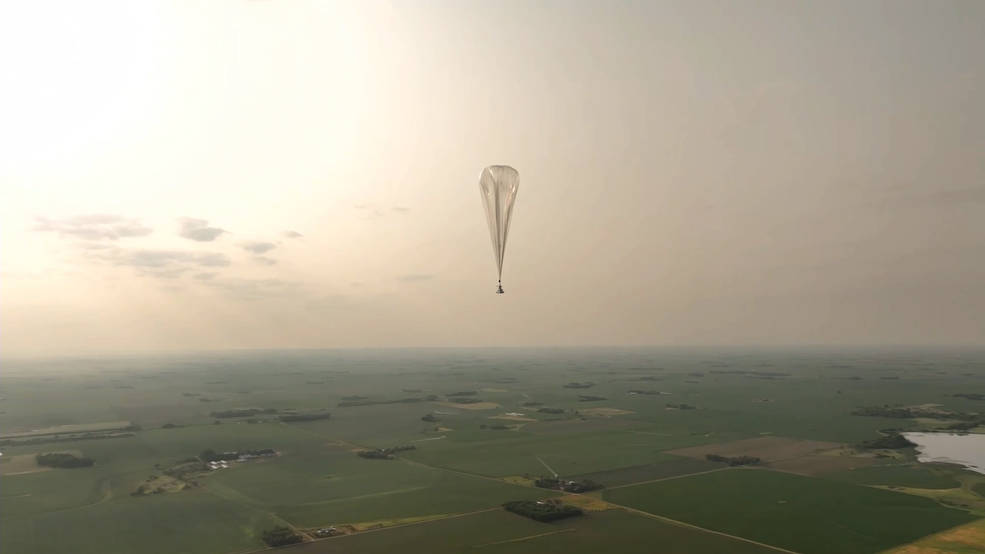迎接挑战:NASA TechRise学生团队开始飞行
Aerostar’s high-altitude balloon is shown here moments after launch carrying payloads from 20 student teams as part of NASA’s TechRise Student Challenge.
Credits: Fresh Produce
Students from 20 middle and high schools watched as their experiments launched aboard a high-altitude balloon on June 14 as part of NASA’s TechRise Student Challenge. The flight is part of a series of suborbital flight tests for TechRise that will continue through the summer.
Led by NASA’s Flight Opportunities program and administered by Future Engineers, TechRise gives student teams a chance to design and build science and technology experiments for flight.
“Flight test is a critical milestone along the path of technology development and scientific discovery, and is essential for tackling some of the most pressing challenges NASA faces.” said Danielle McCulloch, Program Manager for Flight Opportunities at Armstrong Flight Research Center in Edwards, California. “These student payloads address important questions about space and our home planet, and they represent months of skill-building, cooperation, challenges, and accomplishments.”
The high-altitude balloon from Sioux Falls-based Aerostar launched at 7:48 a.m. CDT from Hurley, South Dakota. Student projects flew for over five hours in the stratosphere at approximately 70,500 feet – almost twice as high as commercial planes fly – enabling them to collect data on a variety of space exploration and Earth observation experiments in areas such as remote sensing, climate, and human health. Student teams are now awaiting the return of their payloads to evaluate how their experiments performed in flight.
An experiment from Dickson Middle School in Tennessee examined the effect of solar radiation on synthetic skin samples and the efficacy of various types of sunblock. The team will analyze their data to consider how to prevent skin damage in the upper atmosphere.
Another TechRise experiment called AMONGUS (Atmospheric Measurement of Noxious Gases Using Sensors) also flew. Developed by Sewanhaka High School in Floral Park, New York, AMONGUS used sensors and image data to research the effect of greenhouse gases on climate change.
“To see the culmination of more than a year’s work by students, teachers, Future Engineers, and Flight Opportunities team members has truly been an amazing opportunity,” said Jack Chen, the Sewanhaka teacher leading the school’s TechRise team.
Flight Opportunities is managed at NASA’s Armstrong Flight Research Center in Edwards, California, and is part of NASA’s Space Technology Mission Directorate.
NASA intends to launch the next TechRise Student Challenge this fall. To learn more about TechRise and sign up for updates about future challenges, visit:
https://www.nasa.gov/techrise-student-challenge
6月14日,来自20所初中和高中的学生观看了他们的实验乘坐高空气球升空,这是NASA TechRise学生挑战赛的一部分。这次飞行是TechRise一系列亚轨道飞行测试的一部分,该测试将持续整个夏天。
由NASA的飞行机会项目领导,由未来工程师管理,TechRise为学生团队提供了设计和建造飞行科学技术实验的机会。
“飞行测试是技术发展和科学发现道路上的一个重要里程碑,对于解决NASA面临的一些最紧迫的挑战至关重要。”加利福尼亚州爱德华兹市阿姆斯特朗飞行研究中心的飞行机会项目经理丹妮尔·麦卡洛克说。“这些学生的有效载荷解决了关于太空和我们地球的重要问题,它们代表了数月的技能培养、合作、挑战和成就。”
总部位于苏福尔斯的Aerostar的高空气球于美国东部时间上午7:48从南达科他州赫尔利升空。学生项目在大约70,500英尺的平流层飞行了五个多小时,这个高度几乎是商用飞机飞行高度的两倍,这次飞行使他们能够收集遥感、气候和人类健康等领域的各种太空探索和地球观测实验的数据。学生团队现在正在等待他们的有效载荷返回,以评估他们的实验在飞行中的表现。
田纳西州迪克森中学的一项实验研究了太阳辐射对人造皮肤样本的影响以及各种防晒霜的功效。该团队将分析他们的数据,以考虑如何防止高层大气中的皮肤损伤。
另一项名为AMONGUS(使用传感器对有毒气体进行大气测量)的TechRise实验也进行了飞行。AMONGUS由纽约弗洛勒尔帕克的西温哈卡中学开发,利用传感器和图像数据研究温室气体对气候变化的影响。
“看到学生、老师、未来工程师和飞行机会团队成员一年多的工作成果,真是一个了不起的机会。”领导该校TechRise团队的西温哈卡中学教师Jack Chen说。
飞行机会项目由NASA位于加利福尼亚州爱德华兹的阿姆斯特朗飞行研究中心管理,是NASA空间技术任务理事会的一部分。
NASA打算在今年秋天发起下一届TechRise学生挑战赛。如欲了解有关TechRise的更多信息并注册以获取有关未来挑战的更新,请访问:

